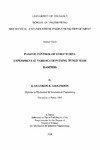Παθητικός έλεγχος των κατασκευών: πειραματική πιστοποίηση αποσβεστήρων ελεγχόμενης μάζας
Passive control of structures: experimental verification using tuned mass dampers
| dc.contributor.advisor | Παπαδημητρίου, Κωνσταντίνος | el |
| dc.creator | Καραΐσκος, Γρηγόριος Κ. | el |
| dc.date.accessioned | 2015-07-24T12:23:32Z | |
| dc.date.available | 2015-07-24T12:23:32Z | |
| dc.date.issued | 2008 | |
| dc.identifier.other | 6452 | |
| dc.identifier.uri | http://hdl.handle.net/11615/14182 | en |
| dc.identifier.uri | http://dx.doi.org/10.26253/heal.uth.1893 | |
| dc.description.abstract | The focus of this thesis is to review and experimentally verify the effect of vibrational control systems applied in tall and flexible structures. The installation of these systems on new and existing structures aim at the spectacular improvement of the structural dynamic behavior under different types of manmade and ambient excitations on the concepts of structural safety and operational conditions. The control theory of this thesis is applied for the design of Passive Control Systems and more specifically for the design of Tuned Mass Damper (TMD) installed properly on the main structure. The main mass of the Tuned Mass Damper, which is named as secondary system, is significantly smaller than the main mass of the primary system which is a Single Degree of Freedom (SDOF) system. A series of experiments with one and two TMDs installed on a SDOF modeled small laboratory structure are designed, constructed and performed. The structural behavior of the laboratory structure was tested by subjecting to artificially induced harmonic excitation and one of the components available during the strong El Centro earthquake. The main modal characteristics of the combined primary-secondary system studied are the modal frequencies, the damping coefficients and the mass ratios between primary and secondary systems. A smart laboratory technique for damping improvement of structures was also employed to both primary and secondary systems and it is shown that sensibly contributes to vibration attenuation of the primary system. All the experimental concepts and results are discussed herein and demonstrate the effectiveness and reliability of Passive Control Systems installed on tall and flexible structures that are susceptible to strong winds and earthquake events. | en |
| dc.language.iso | en | en |
| dc.rights | Attribution-NonCommercial-NoDerivatives 4.0 International | en |
| dc.rights.uri | http://creativecommons.org/licenses/by-nc-nd/4.0/ | en |
| dc.subject.other | ΔΟΜΙΚΕΣ ΚΑΤΑΣΚΕΥΕΣ | el |
| dc.subject.other | ΔΟΜΙΚΗ ΑΝΑΛΥΣΗ (ΜΗΧΑΝΙΚΗ) | el |
| dc.title | Παθητικός έλεγχος των κατασκευών: πειραματική πιστοποίηση αποσβεστήρων ελεγχόμενης μάζας | el |
| dc.title | Passive control of structures: experimental verification using tuned mass dampers | en |
| dc.type | masterThesis | en |
| heal.recordProvider | Πανεπιστήμιο Θεσσαλίας - Βιβλιοθήκη και Κέντρο Πληροφόρησης | el |
| heal.academicPublisher | Πανεπιστήμιο Θεσσαλίας. Πολυτεχνική Σχολή. Τμήμα Μηχανολόγων Μηχανικών Βιομηχανίας. | el |
| heal.academicPublisherID | uth | en |
| heal.fullTextAvailability | true | en |
| dc.rights.accessRights | free | en |
| dc.contributor.committeeMember | Παπανικολάου, Παναγιώτης | el |
| dc.contributor.committeeMember | Καραμάνος, Σπύρος | el |



